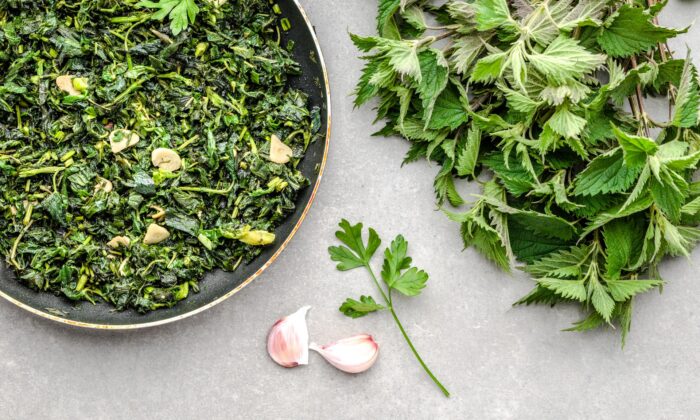
Grandma’s vegetable garden, in a village called Crangeni in the Muntenia region of Romania, runs downhill toward a wetland formed by the thinning stream of the Calmatui River. It’s flanked by two diamond hole wire fences, while the marsh is a natural boundary.
Some minute rills that flow into the river form a small pond at the bottom of the garden plot. The fertile soil surrounding it is a perfect habitat for all kinds of mud-sucking perennial plants. There, stinging nettles thrive.
They took over the marshes and spread upward over the garden grounds, following the wire fences’ unconventional borders, like voluntary sentinels, ready to fight and die for their realm. At least, this is what I imagined as a child when Grandma put a sock on my hand to teach me how to forage for them, tip by tip.
The sock was supposed to protect my delicate skin against the nettles’ bite. It never worked. I could feel those tiny leaves stinging my flesh through the thickest cotton weave. I still remember the red blisters and the cringing pain that followed. It sometimes lasted for days, but we did nothing against it because it was believed that pain was a panacea of sorts. The pain was worth it, though, for the taste of a dish that Grandma called “spring’s blessing.”
Legends and Traditions
We always foraged for stinging nettles in spring, before Palm Sunday. In Romanian folk culture and pagan traditions, that day is identified as “the nettles’ wedding,” as the plants start to blossom. They say nettles are no longer edible after this sacred day, because once they start flowering, the tiny purple blossoms eat all the nutrients, rendering the leaves unusable for culinary purposes. This warning rings true beyond superstition, too: Once nettles flower and mature, they develop cystoliths in the leaves, which can irritate the urinary tract.
In Romania, nettle dishes are common during Lent, when followers of the Greek Orthodox rites don’t consume any foods derived from animals.
These plants have a meaningful legend behind them, too. They say a poor man once wanted to give something back to the people who pitied and fed him in his time of need. He saved every penny for months, and when he had enough, he bought all kinds of cold cuts to fix a fancy feast, but no one showed up. Saddened, he buried all the meat in his field. God gave him a patch of nettles on that spot, so he would never go hungry again.
But he still wanted to share, so he cooked a feast with the plants—and the whole village showed up. Miracles bring people together that way.
A Springtime Superfood
Each season, we fixed nettle soup or a garlicky sauté, along with that dish my grandma called “spring’s blessing,” an invigorating green purée. But it was nettle tea, brewed with a pinch of salt, that I loved the most. The infusion has a metallic aftertaste, and a faint marshy odor reminiscent of the bog and decaying forest leaves in autumn—probably not the average person’s cup of tea. I used to drink the hot brew after every harvest in my childhood.
“Drink—it’s health in a cup,” my grandma used to say.
She didn’t have to insist, for I liked the taste—long before I knew the potion was rich in amino acids, iron, and other minerals, vitamins A, B, C, and K, and more. At the time, it didn’t matter. It still doesn’t, although now it’s good to know that a childhood “vice” is actually a superfood.
Generally, Romanians consider the nettle a miraculous plant. It’s both a culinary delicacy and a medicinal herb. Nettle tea can help boost urinary tract health, flushing harmful bacteria, and can benefit people with arthritis and sore muscles, too. You can even use it on your hair to fight dandruff. Recent medicinal studies have found plenty to support these popular folk beliefs.
Finding Nettles
In time, I learned to forage for nettles with my bare hands. I pluck the very tip of the plant—the part that stays closed, almost like a bud—by grabbing the stem underneath, careful not to touch the leaves. This part is very tender, and it will cook quickly. I don’t use scissors, but many people might find them helpful to avoid the sting. The stems still sting me, but not as much as you’d think.
(I stopped at the first next picture)
https://www.theepochtimes.com/taming-th ... 2021-04-22